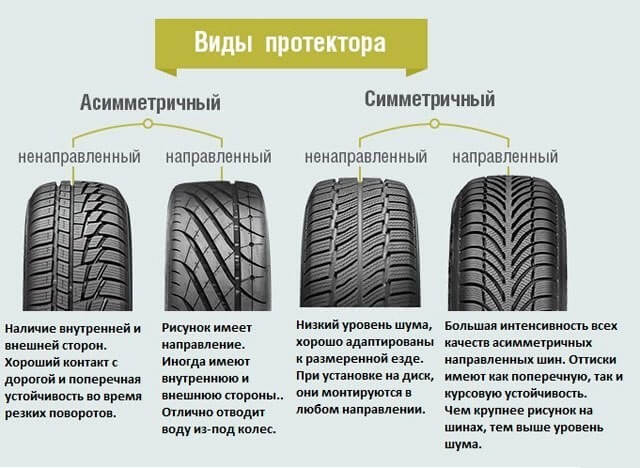
Types of car tires - what is the significance of the tread pattern in tires? Introducing the most popular types of tires!
Content
Different types of tires can be identified by their markings. A common abbreviation, such as 185/75/R14/89T. The information refers to tire width, aspect ratio, radial sandwich construction, rim diameter, and maximum speed and load capacity respectively.
Summer tires
This type of tire is characterized by the fact that it performs best at temperatures above 7 degrees Celsius. It is in such conditions that it provides less braking time - compared to the winter and all-season variety. In addition, summer tires perform very well on both wet and dry surfaces.
Winter tires
They have been designed and engineered to ensure the safety and good driving performance of the vehicle in low temperatures and on icy or frosted surfaces.
The rubber compound used in them is much more effective than summer and all-season versions in the temperature range below 7 degrees Celsius. It contains a larger amount of rubber additive that hardens at low temperatures and provides better adhesion.
In this case, the type of tread also plays an important role. It has thin grooves cut into it. In addition, there are wider channels. Thanks to this, the tires “grab” the snow better and separate the water or the so-called. slush from the surface of the tires.
All season tires
This is a compromise between summer and winter tires. All-season tires are designed to work all year round, regardless of weather conditions. All-season tires provide safety and optimal driving quality in the temperature range from -10 to 30 degrees Celsius.
Despite this, they are not as efficient as the summer version - they do not work as well on dry and warm surfaces or winter ones - the parameters related to braking time and grip also leave much to be desired. The two mentioned versions work better in the extreme range of positive and negative temperatures.
Energy efficient tires
The variety is different in that it allows you to improve the parameters of fuel combustion. They are most often installed as original equipment in hybrid or electric vehicles. They can reduce the rolling resistance of tires on asphalt, which is a key factor in driving fuel economy in electric or hybrid vehicles.
The disadvantage of this type of tires is that they provide worse driving dynamics than the standard varieties. All this is complemented by less satisfactory parameters related to braking distance and cornering grip, especially on wet surfaces. However, this is offset by lower fuel consumption.
Low profile tires
This type of tire is used in sports and performance vehicles. Their design was created with the idea of using the full potential of the car. Accordingly, they are wider than the usual varieties. They provide the largest contact surface with asphalt. In addition, the depth of the tires is relatively small compared to the width.
This allows the rider to get maximum traction when accelerating, braking and cornering on dry surfaces. A small sidewall improves tire stability - especially when subjected to high braking, acceleration or centrifugal forces when cornering. Unfortunately, low profile tires than conventional tires. They also wear out faster.
Tires
They differ in that they have a reinforced design of the side walls. Its work affects the better retention of the car's weight - including when air pressure drops, for example, due to a puncture.
Their biggest advantage is considered to be a more effective impact on security. This is because a standard tire can dangerously fall apart when its structure is compromised, while a run-flat version will retain its structural integrity and allow the driver to decelerate safely.
What to remember when installing run-flat tires?
This variation is assembled by several car manufacturers. This means that not all cars are designed to run with these tires - the car must have a specially tuned suspension system to better handle the stiffer sidewalls.
Another important piece of equipment is the TPMS tire pressure monitoring system. Thanks to this, you can avoid unconsciously driving with a flat tire for a long time or at a higher speed.
Alternative to RunFlat Tires
An alternative to run-flat tires is available on the market. These are ContiSeal sealing bars. Inside it is a sticky sealing layer. It is able to fill punctures up to 5 mm in diameter and prevent deflation.
4×4 off-road tires
They can be divided into two subgroups. The former has a thick enough tread pattern to provide decent grip and performance on and off road. The second has a more aggressive pattern and much larger gaps between the tread blocks. Works great on sticky mud, rocks or gravel. It does not have such good driving performance when the driver decides to drive off-road onto a paved road.
Asymmetric and directional tires
This variant has different tread patterns on the inner and outer edges. In the first case, the blocks are smaller and designed to drain water and improve wet grip. Secondly, rigid blocks help in turns. In this case, there is a solid rib in the middle of the tread. This helps to maintain stability in a straight line.
Directional tires are designed to spin in one direction only, as indicated by an arrow embossed on their surface. This variant differs in that it dissipates water that accumulates in the front of the tire much better. It does not create road noise and improves directional stability.
Temporary tires
Cars are usually also equipped with temporary tires. These are special tires designed to save space and weight.. Therefore, there may be a certain speed limit associated with their use, for example up to 80 km/h. They are used in emergency situations.